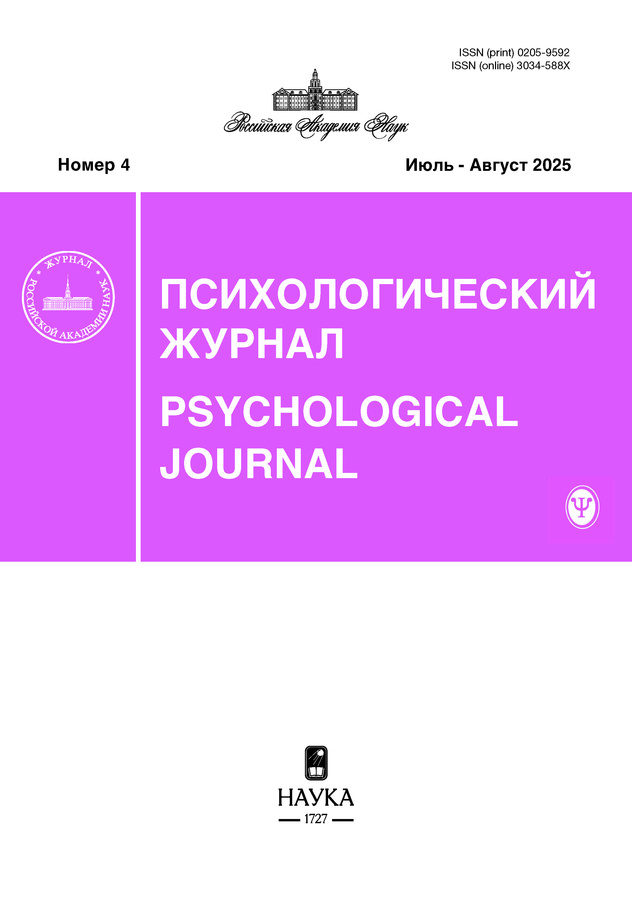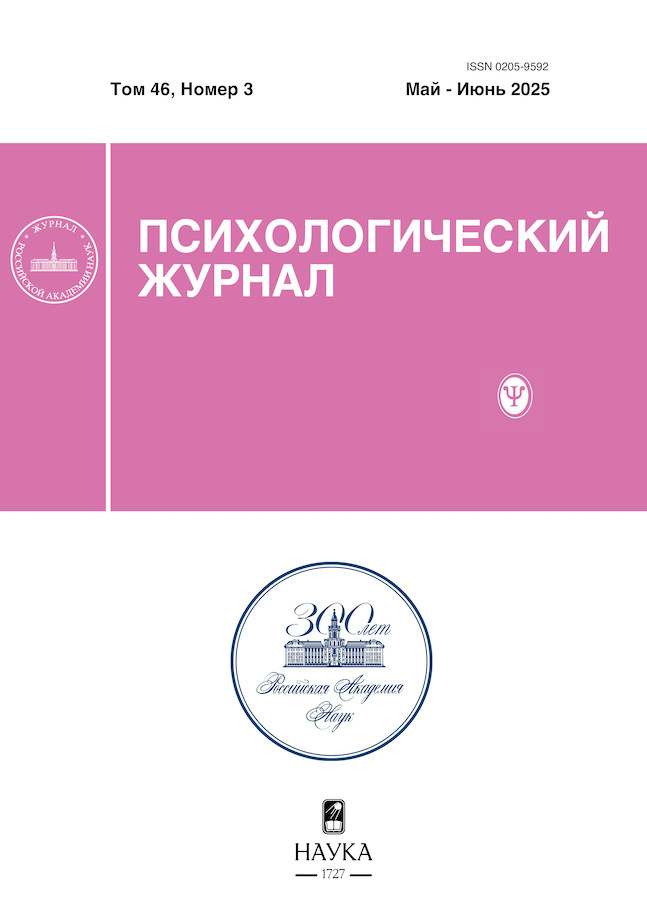Поведенческие показатели при научении различению коротких интервалов времени
- Авторы: Луговских Е.М.1, Апанович В.В.1,2, Юдаков К.С.1,2, Арамян Э.А.2, Гладилин Д.K.2,3, Александров Ю.И.1,2
-
Учреждения:
- ФГБОУ ВО “Государственный академический университет гуманитарных наук”
- ФГБУН Институт психологии РАН
- ФГБОУ ВО Московский государственный психолого-педагогический университет
- Выпуск: Том 46, № 3 (2025)
- Страницы: 99-111
- Раздел: Психофизиология
- URL: https://ter-arkhiv.ru/0205-9592/article/view/688379
- DOI: https://doi.org/10.31857/S0205959225030094
- ID: 688379
Цитировать
Полный текст
Аннотация
В рамках исследования процесса приобретения нового навыка в работе сопоставлялись группы участников исследования, демонстрирующих разную степень научения и усовершенствования навыка, формируемого с помощью психофизической методики “Да/Нет”. Предполагалось, что при научении новому навыку участники исследования могут приобретать новый опыт с разной скоростью и, таким образом, после одинакового количества поведенческих актов взаимодействия с задачей иметь разную степень сформированности новой функциональной системы, что будет проявляться в различиях во времени ответа, показателе “чувствительности” d’ и в критерии принятия решения β. Одна группа участников (N = 28, от 18 до 45 лет, медиана 19 лет, 7 мужчин, 21 женщина) исследования обучались задаче различения коротких интервалов времени, предъявляемых в зрительной модальности, в течение одной сессии, а вторая группа (N = 51 от 18 до 32 лет, медиана 22 года, 27 мужчин, 24 женщины) проходила аналогичное обучение за две сессии с интервалом в сутки. Было показано, что такие эффекты, как смещение показателя критерия принятия решения β, его независимость от показателя “чувствительности” d’, а также более длительное время для категории ответа “Нет, не было различий” по сравнению с категорией ответа “Да, были различия”, наблюдались только в группах более результативных участников исследования (демонстрирующих навык без предварительного обучения) по сравнению с другими группами участников (во всех случаях при p ≤ 0.05). В группах менее результативных участников исследования (не научившихся и научившихся по ходу эксперимента) эти феномены не наблюдались. Полученные результаты интерпретируются с позиций системно-эволюционного подхода на основе представлений о системогенезе и количестве степеней свободы нейрона и организма, наблюдаемых на этапе рассогласования и после завершения процесса системогенеза.
Полный текст
Об авторах
Е. М. Луговских
ФГБОУ ВО “Государственный академический университет гуманитарных наук”
Автор, ответственный за переписку.
Email: eugenelugovski@gmail.com
Магистрант факультета психологии
Россия, 119049, г. Москва, Мароновский пер., д. 26В. В. Апанович
ФГБОУ ВО “Государственный академический университет гуманитарных наук”; ФГБУН Институт психологии РАН
Email: apanovitschvv@yandex.ru
Кандидат психологических наук, доцент кафедры экспериментальной психологии и психодиагностики факультета психологии ГАУГН, научный сотрудник лаборатории психофизиологии им. В.Б. Швыркова ИП РАН
Россия, 119049, г. Москва, Мароновский пер., д. 26; 129366, г. Москва, ул. Ярославская, д. 13, корп. 1К. С. Юдаков
ФГБОУ ВО “Государственный академический университет гуманитарных наук”; ФГБУН Институт психологии РАН
Email: kost05062000@mail.ru
Преподаватель кафедры экспериментальной психологии и психодиагностики факультета психологии ГАУГН, аспирант и младший научный сотрудник лаборатории психофизиологии им. В.Б. Швыркова ИП РАН
Россия, 119049, г. Москва, Мароновский пер., д. 26; 129366, г. Москва, ул. Ярославская, д. 13, корп. 1Э. А. Арамян
ФГБУН Институт психологии РАН
Email: aramyan.eric@gmail.com
Аспирант, младший научный сотрудник лаборатории психофизиологии им. В.Б. Швыркова
Россия, 129366, г. Москва, ул. Ярославская, д. 13, корп. 1Д. K. Гладилин
ФГБУН Институт психологии РАН; ФГБОУ ВО Московский государственный психолого-педагогический университет
Email: dima.gladilin.psy@gmail.com
Аспирант, младший научный сотрудник лаборатории психофизиологии им. В.Б. Швыркова ИП РАН, лаборант-исследователь Института экспериментальной психологии МГППУ
Россия, 129366, г. Москва, ул. Ярославская, д. 13, корп. 1; 127051, г. Москва, ул. Сретенка, д. 29Ю. И. Александров
ФГБОУ ВО “Государственный академический университет гуманитарных наук”; ФГБУН Институт психологии РАН
Email: yuraalexandrov@yandex.ru
Академик РАО, доктор психологических наук, профессор, зав. лаборатории психофизиологии им. В.Б. Швыркова ИП РАН, зав. кафедры психофизиологии факультета психологии ГАУГН
Россия, 119049, г. Москва, Мароновский пер., д. 26; 129366, г. Москва, ул. Ярославская, д. 13, корп. 1Список литературы
- Александров Ю.И., Горкин А.Г., Созинов А.А., Сварник О.Е., Кузина Е.А., Гаврилов В.В. Консолидация и реконсолидация памяти: психофизиологический анализ // Вопросы психологии. 2015. № 3. С.133–144.
- Александров Ю.И., Дружинин В.Н. Теория функциональных систем в психологии // Психологический журнал. 1998. Т. 19. № 6. С. 4–19.
- Анохин П.К. Принципиальные вопросы общей теории функциональных систем // Принципы системной организации функций. М.: Наука, 1973. С. 5–61.
- Апанович В.В., Арамян Э.А., Гладилин Д.Л., Юдаков К.С., Карпов С.А., Горкин А.Г., Александров Ю.И. Разработка и апробация психофизической методики исследования приобретения и совершенствования навыка // Экспериментальная психология. 2022. Т. 15. № 3. С. 222–223.
- Апанович В.В., Юдаков К.С., Егорова П.И. Разработка принципа анализа динамики психофизического показателя d’ с применением метода “скользящего окна” // Психологический журнал. 2024. Т. 45. № 5. С. 65–76.
- Войтенко Т.П. Сенсорная тренировка как фактор развития чувствительности: Дис. … канд. психол. наук. М., 1989.
- Гусев А.Н. Психофизика сенсорных задач: системно-деятельностный анализ поведения человека в ситуации неопределенности. М.: Изд-во Моск. ун-та; УМК “Психология”, 2004.
- Гусев А.Н., Измайлов Ч.А., Михалевская М.Б. Измерение в психологии: общий психологический практикум. 2-е изд. М.: Смысл, 1998.
- Забродин Ю.М., Пахомов А.П., Шаповалов В.И. Взаимосвязь эффективности обнаружения сигнала / Психофизика сенсорных и сенсомоторных процессов / Под ред. Ю.М. Забродин. М.: Наука, 1984.
- Лисенкова В.П., Шпагонова Н.Г. Индивидуальные и возрастные особенности восприятия времени взрослыми людьми // Психологический журнал. 2021.Т. 42. № 5. С. 5–16.
- Пахомов А.П. Динамичность показателей обнаружения сигналов в психофизических исследованиях // Проблемы инженерной психологии. М.: Наука, 1979. С. 73–74.
- Скотникова И.Г. Проблемы субъектной психофизики. М.: Институт психологии РАН, 2008.
- Скотникова И.Г., Иванов М.А. Экспериментальное исследование восприятия равенства–различия длительностей // Исследования по когнитивной психологии / Под ред. Е.А. Сергиенко. М.: Институт психологии РАН, 2004. С. 94–120.
- Скотникова И.Г., Шендяпин В.М., Садов В.А., Панова Е.В., Журкина Е.В. Соотношение уверенности в решении с его правильностью, латентностью и характеристиками сенсорной задачи // Экспериментальный метод в структуре психологического знания. Отв. ред. В.А. Барабанщиков. М.: Институт психологии РАН. 2012. С. 123–128.
- Шапкин С.А., Дикая Л.Г. Деятельность в особых условиях: компонентный анализ структуры и стратегии адаптации // Психологический журнал. 1996. Т. 17. № 1. С. 19–34.
- Швырков В.Б. Введение в объективную психологию. М.: Изд-во Институт психологии РАН, 1995.
- Шендяпин В.М., Скотникова И.Г. Моделирование принятия решения и уверенности в сенсорных задачах. М.: Институт психологии РАН, 2015.
- Юдаков К.С., Гладилин Д.Л., Апанович В.В., Арамян Э.А., Александров Ю.И. Описание типичных компонентов ССП, проявляющихся при решении задачи различения коротких интервалов времени // Экспериментальная психология. 2025. Т. 18. № 2. В печати.
- Broadbent D.E., Gregory M. Vigilance considered as a statistical decision // British Journal of Psychology. 1963. № 54. P. 309–323.
- Green D.M., Swets J.A. Signal detection theory and psychophysics. N.Y.: Wiley, 1966.
- Krueger L.I. A theory of perceptual matching // Psychological Review. 1978. V. 5. P. 278–304.
- Luce R.D. Response times. Their role in inferring elementary mental organization. N.Y.: Oxford University Press, Clarendon Press. Oxford, 1986.
Дополнительные файлы















